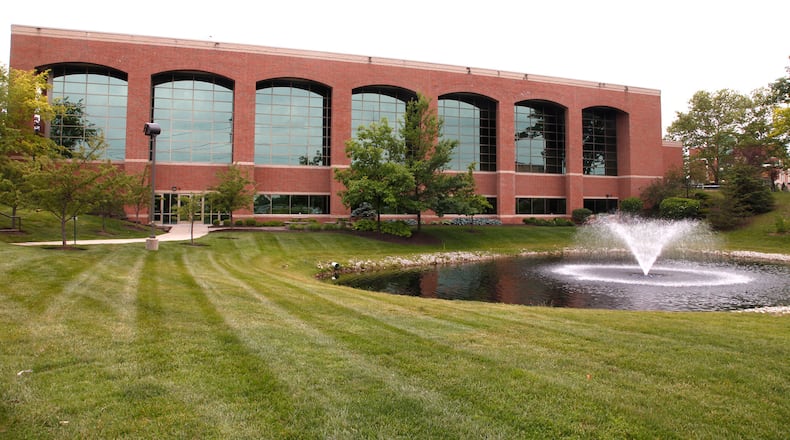“Double Bowler’s focus since its inception has been to expand the university’s footprint to the south of Colonel Glenn Highway,” said Greg Sample, Double Bowler’s president and only employee.
He said the non-profit can operate quicker and with more flexibility than the university can on its own.
“The private real estate market operates at a much quicker pace than does the university world…which is why you’ll see universities not be successful in the realm of real estate,” said Sample, whose prior jobs included president of Austin Landing developer RG Properties.
WSU Board of Trustees Chairman Michael Bridges sits on Double Bowler’s volunteer board of directors. He responded to questions about Double Bowler with a prepared statement.
“Working with president (David) Hopkins, we’ve been working to identify and implement best practices from many places, including the private sector, where I work,” said Bridges, president of a defense research and consulting firm.
“In the private sector, we use creative techniques to expand so that potential competitors can’t block our progress. By establishing Double Bowler, we’ve done that in the area of land acquisition.”
Other universities have used similar models, Sample said. Ohio State University, for example, is using the non-profit Campus Partners to redevelop land around the university. The group has been credited with modernizing and revitalizing run-down neighborhoods, though it has also encountered financial problems and concerns about gentrification.
Ohio University economist Richard Vedder worried that the trend for universities to create non-profit property development arms creates liabilities for the schools while straying from their public purpose.
“It is, in my view, getting universities farther away from the core mission, which is teaching and research, into other things,” he said. “Anything they’re doing that involves in some sense a financial commitment on the university’s part is going to be potentially something of a burden if it doesn’t work out the way they planned.”
Double Bowler Properties has a seven-member governing board consisting of three members of WSU’s board of trustees, along with the university’s chief financial officer, executive vice president and senior advisor to the provost.
“The trustees and the administration worked together to provide the oversight necessary for a project of such importance to the university,” Bridges said.
In applying for IRS non-profit status, which it received in April, Double Bowler said its “activities will be comprised of acquiring real property in the areas surrounding the WSU campus for the benefit of WSU. Substantially all of the property acquired by purchase will be leased at cost (to the school).”
It says it has acquired four properties and leased them to WSU. The university could not provide the total amount of funds it has paid to Double Bowler.
Double Bowler also took ownership of the Calamityville building in Fairborn, and purchased a pair of residential lots in Dayton that can be used to add parking to the Duke E. Ellis Human Development Institute.
No-bid construction work
The university in May received state approval to award Double Bowler a no-bid contract to build a $2.75 million salt barn on the campus. The project was initially bid out, but the bids were thrown out after negotiations with private sector construction companies couldn’t bring the price down enough.
“It’s frustrating,” said Doug Seyferth, president of Seyferth Construction, which initially won with a $3.6 million bid and said he couldn’t get the price down any lower with the scope of the proposed project.
The project was heralded as a grand example of intergovernmental collaboration because, in addition to relocating WSU’s current grounds maintenance yard, it will create a shared salt barn with the Ohio Department of Transportation, and the cities of Beavercreek and Fairborn.
Sample said Double Bowler took over the contract last month after the project had run into delays. Though he is sub-contracting the entire project, the non-profit is able to skirt some government regulations that wouldn’t be possible if the university bid out the work, he said.
ODOT hopes to have the salt barn built by November.
Wright-Patt HQ
Greene County property records and non-profit records show Double Bowler paid $5.8 million for a pair of buildings in Fairborn including the 65,222-square-foot former Wright-Patt Credit Union headquarters on Executive Park Boulevard and a 27,032 square-foot building next door.
The university signed an agreement with Double Bowler to lease part of the property for payments of $167,500 every six months with options to renew through the year 2034.
Double Bowler has also sub-leased part of the property to the Hallmark Title Agency.
Sample said revenue from other tenants will decrease the lease for Wright State. He said getting tenants shouldn’t be difficult because the non-profit can offer lower-than-market rates.
“We need to cover operating costs and debt payment and capital improvement,” he said. “Other than that there’s no profit.”
Currently, university administrative offices are temporarily housed in one building. Wright State is considering using the other building to house its extensive archives of Wright brothers memorabilia currently on the fourth floor of the library.
Lake campus expansion
Double Bowler paid $750,000 last week to buy 38.6 acres of farmland east of the university’s lake campus along Grand Lake St. Mary in Mercer County.
Julie Miller, development officer for the lake campus, said likely uses for the land include an advanced manufacturing center where students can get hands-on experience with modern robotics and welding equipment; a water quality research institute to look for solutions to surface water problems such as algae; and an athletic complex for the campus’ growing residential population.
More than $20 million in private and public funding will pay for these amenities, she said.
Sample and university officials said they don’t want to tip their hand on any future purchases because that could cause the prices to go up. But he said any activity will directly support the university.
“We’ve got some pretty neat and potentially interesting things that will be coming out of the pipeline,” he said.
About the Author

